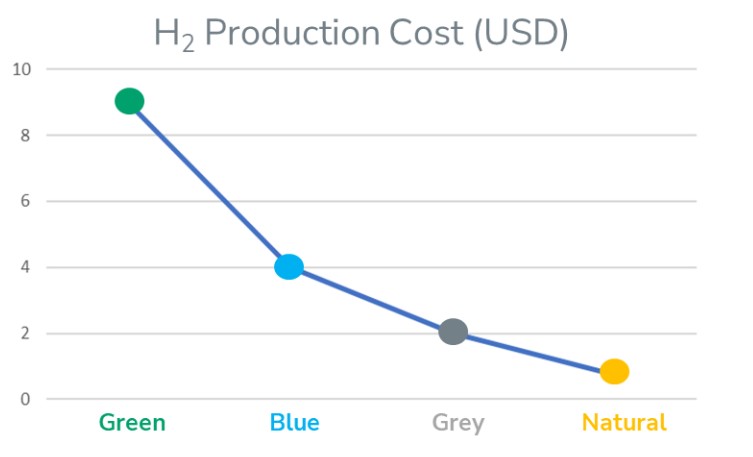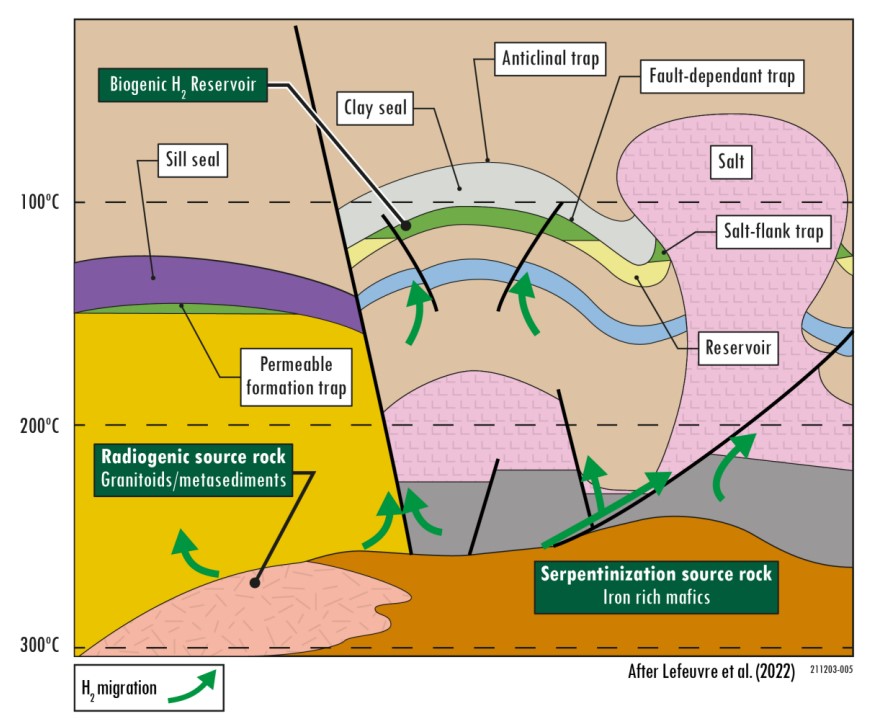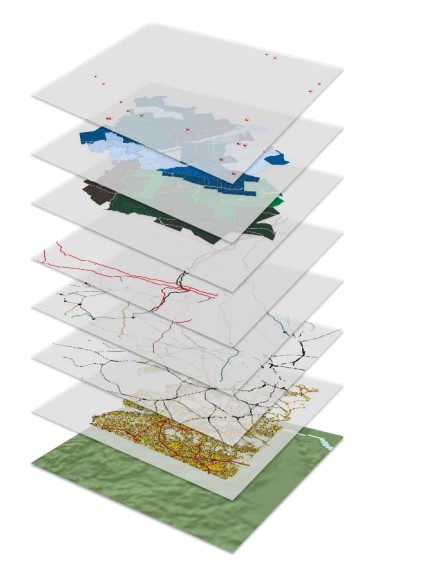Introduction
Hydrogen is widely accepted as an integral piece of the energy transition jigsaw puzzle. Its projected global demand is forecast to rapidly increase, growing from 94 million tonnes/year in 2021 to 200 million tonnes/year in 2030 according to the IEA. Up until now most of this demand (99.6 % according to a 2020 report by Wood MacKenzie) has been serviced by hydrogen produced through the steam reforming of coal or natural gas (known as “grey” and/or “blue” hydrogen; see Figure 1). However, these processes are not suitable long-term solutions due to their inherent production of CO2.
Green hydrogen (see Figure 1) is much more climate friendly as it is powered by renewable energy and does not produce notable greenhouse gas emissions though its operation. Unfortunately, there are hurdles to manufacturing green hydrogen as it can be costly compared with more conventional production methods3 and so may be a less efficient use of renewable resources (see Figure 2).
Natural (sometimes also referred to as “white”, “gold” or “native”) hydrogen is a promising source of this valuable commodity due to its low production cost (~$1/kg) as well as its lack of associated greenhouse gas emissions.

Figure 1: Selected ‘Colours of Hydrogen’ after4

Figure 2: Current production costs for different types of hydrogen (without any subsidies).
Data from3 .
Mineral Systems Analytical Approach
Getech has designed a robust workflow utilising the Mineral Systems Analysis approach5 to predict the location of natural hydrogen deposits in the subsurface, which manifest themselves much like mineral or hydrocarbon deposits.
Our workflow builds on the understanding of genetic factors involved in developing a natural hydrogen system – categorising these into sources, migration paths, reservoirs, traps and seals in much the same way as the petroleum industry has successfully done for many decades.
Getech’s internal databases (including Globe and our Gravity and Magnetic data holdings) provide data layers and proxies which can form the base of an analytical process, performed using proprietary machine learning / artificial intelligence workflows and powerful geospatial risk mapping software such as Exploration Analyst.
The ultimate goal of this process is to create favourability maps (similar to hydrocarbon play based exploration maps) which are validated using known occurrences of natural hydrogen and which can provide clear targets for more focused evaluation efforts away from known hydrogen occurrences (see Figure 3).

Figure 3: Workflow of natural hydrogen exploration, showing how Getech can de-risk regional evaluations to allow more detailed exploration with a higher probability of success
The first two formation methods require the presence of source rocks such as ultramafics or granitoids, respectively, but are also conditional on the presence of meteoric water and its ability to interact with these source lithologies.
Precise mapping of surface outcrops of these rocks forms the starting point; however, significant added value comes from analysing gravity and magnetic data to estimate the rocks’ subsurface extent through the mapping of:
1) Extremely high magnetic susceptibilities, normally associated with the process of serpentinization
2) Relatively low densities and magnetisation of granitic bodies against their neighbouring crustal lithologies
3) Structural settings of such bodies and the modelling of pathways for meteoric water which may be provided by associated faults
 Figure 4: Schematic diagram illustrating some components of natural hydrogen systems (after13), showing some of the main source mechanisms favourable to Getech’s Mineral Systems Analysis
Figure 4: Schematic diagram illustrating some components of natural hydrogen systems (after13), showing some of the main source mechanisms favourable to Getech’s Mineral Systems Analysis
Migration
Once the free H2 gas has been liberated from the source rocks, it needs to migrate to a formation or structure where it can collect. Migration is primarily expected to be by advection, which occurs mainly along faults and fractures, as proposed in the northern Pyrenees14. Structural analysis provides the framework for mapping conduits, but this also needs to incorporate stress field analysis to understand if these faults are ‘open’ or ‘closed’.
A secondary migration pathway, diffusive migration, should also be considered. This occurs where free H2 permeates through porous sedimentary rocks, similar to the diffusive migration exhibited by helium and nitrogen15. This assessment is supplemented using Getech’s palaeogeographical and palaeogeological data from Globe to model the source lithologies which were eroded through geological time to form these sedimentary units and, therefore, enable us to assess the porosity and permeability characteristics of these strata.
There may be further geological factors which allow the subsurface migration of hydrogen within a dissolution state, i.e. dissolved within groundwater rather than the free gas migration associated with advection of diffusion. This has been proposed in connection with the Mid-Continental Rift of the USA, where natural hydrogen exploration is being undertaken by HyTerra in Nebraska and Kansas. In this setting, rainwater falling in the uplands in Colorado (500 to 600 km distance) charges two regional aquifers (the shallower Great Plains aquifer and the deeper Western Interior Plains aquifer) which flow eastwards, absorbing H2 during their flow before rising to shallower levels in the subsurface where they have been sampled by numerous wells over the Nemaha Ridge16,17.
At Getech, we use our proprietary palaeoreconstructions to calculate precipitation rates at any point through geological time to help determine where groundwater was likely to interact with subsurface rocks to produce hydrogen.
Traps and Seals
One of the most important components of a natural hydrogen system is the mechanism(s) by which it retains any potential reserve through traps and/or seals (see Figure 5).
Traps can be structural (e.g. anticlines), lithological (e.g. salt diapirs) or against ‘closed’ or sealing faults (showcasing another need to understand the present day & historic stress field in the localities of possible natural hydrogen systems).
Vertical barriers to H2 escape are likely to require one of a possible number of competent and relative impermeable layers such as evaporites, clays, tight shales or even unfractured igneous lithologies (e.g. the Bourabougou Field in Mali18) – these can all be modelled and/or predicted using a variety of data and methods depending on which sealing caprock is most likely to be present within the natural hydrogen system.

Figure 5: Schematic diagram (after14) illustrating some components of natural hydrogen systems, showing just some of the main source mechanisms, migration paths and seals considered within Getech’s Mineral Systems Analysis
Thermal Regime and Timing Factors
Once these lithological constraints have been accounted for, there are other considerations which determine the likelihood of any notable hydrogen generation as well as retention within a reservoir accumulation.
The first of these is the geothermal regime within these H2 systems. H2-consuming microbes, which exist at shallow depth in the subsurface, would be detrimental to the continued accumulation of H2. These microbes remain active (assuming other factors are hospitable) at temperatures up to ~60 or ~100°C (depending on the particular species)19, so any potential H2-filled reservoir would ideally be located at depths greater than the 100 °C isotherm.
Other thermal considerations would involve the temperatures associated with the initial generation of H2 within the source rock. Biogenic hydrogen generation (at least that formed through thermogenic processes), is believed to occur at temperatures between 160 and 250°C12.
There is some uncertainty about the temperature range of serpentinization; however, we are adopting an upper thermal cut-off of ~350°C20.
Combining each of these isotherm constraints can easily be achieved using our in-house global geothermal data layers (see Figure 6) which have been refined using the latest machine learning algorithms.

Figure 6: Example of depth isotherms (top: 100 °C; bottom: 350°C) to give an example of how Getech can confine the exploration depth window
Further to understanding the temperature factors, it is also important to classify the temporal components of any potential natural hydrogen system. The starting question may be: is any possible hydrogen system being charged by Present Day source processes or was the majority of H2 generated at some point within the geological history of the system?
Constructing a hydrogen systems chart, following the same principles as frequently used petroleum systems charts, to evaluate each prospect would prove very useful. Such a chart could also answer some other questions such as:
- Is any current generation of free H2 in the subsurface either filling a non-seeping hydrogen reservoir or topping up one which is exhibiting some H2 leakage?
- Even if free H2 is being actively supplied from the source rock(s), what age of stratigraphy could be providing the reservoir and/or seals?
- If the current source rock(s) are no longer producing, when were the most likely times of pulse(s) of free hydrogen generation?
Results and Next Steps
Once all relevant data layers, proxies and associated considerations have been understood and attributed to global spatial data sets, comprehensive analyses of these can commence. The end-product of this is a ‘play map’ showing the relative favourability for the presence of all components needed for a natural hydrogen system to be in place (see Figure 3).
It may be necessary to generate a suite of different favourability maps for different source mechanisms. These maps can be validated using known H2 occurrence data to provide extra confidence in the resulting ‘play maps’, and overlain with infrastructure knowledge (e.g. markets, transportation; see Figure 7) to further high-grade commercially appealing areas to target any follow-on exploration.

Figure 7: Diagram illustrating the process of overlaying numerous ‘above ground’ data layers, such as hydrogen infrastructure, legislative variations, etc
Conclusions
Hydrogen is set to play a significant role as the world transitions to a lower carbon future. The Mineral Systems Approach to targeting natural hydrogen reserves is showing great potential in de-risking regional-and local-scale natural hydrogen exploration projects.
Getech’s unique and proprietary global geoscience data layers are invaluable during an initial screening project and significantly de-risk subsequent detection phases in H2 exploration, especially in conjunction with modern machine learning predictive techniques.
Getech has already developed mineral systems approaches to target other critical minerals (sediment-hosted copper, sedimentary exhalative (SEDEX) zinc-lead and sedimentary lithium deposits to name a few), and we see significant benefits in applying this same genetic approach to target natural hydrogen.
For further discussion on this fast-developing topic, please contact the Getech team at info@getech.com
Written by David Tierney and Howard Golden
KeyFacts Energy Industry Directory: GETECH
 KEYFACT Energy
KEYFACT Energy